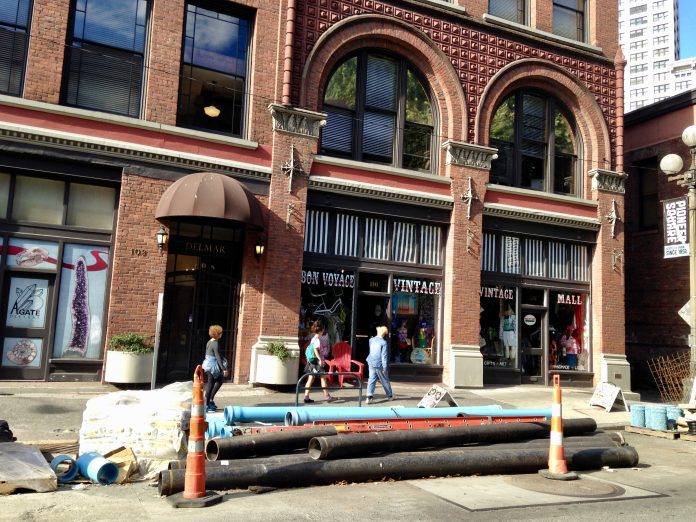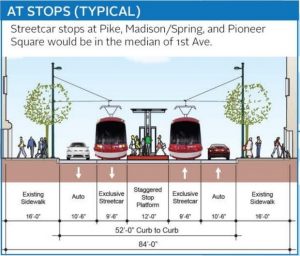Pioneer Square has the most to potentially lose–but also gain–from the connection of Seattle’s downtown streetcar lines.
During her daily commute into Pioneer Square on Link light rail, Lauren Davis, who is assistant director of ArtXchange Gallery, noticed a change in ridership after the completion of the Capitol Hill and University of Washington stations in 2016.
“The cars are packed,” said Davis. “It’s clear that people in Seattle are hungry for connected transit systems.”
Davis is hopeful that Center City Connector (CCC) will offer Pioneer Square access into another connected system. As the director of a well-established gallery on 1st Avenue just south of S. Jackson Street, Davis knows that customer access is essential to her gallery’s success, and she is tired of listening to customer’s frustrations about “circling for an hour for a park spot.”
“I would personally like to have the CCC in the long run,” said Davis. “If the [streetcar] connector were finished and there were new resources for parking, I think that would be ideal.”
On July 24th Mayor Durkan released a letter explaining her decision to halt construction of the CCC, pending completion of a technical review by the firm KPMG. While the fate of the CCC hangs in the balance, no other neighborhood is waiting for what comes next with as much anticipation as Pioneer Square. Because of the utility work being completed on 1st avenue, the neighborhood has already been living with the painful reality of being stuck in the middle of a major road construction project for several months.
Beloved by its residents and stakeholders, Pioneer Square is a place where people choose to locate their lives and businesses, despite the hardships the neighborhood has faced over the years. Recently, more and more small businesses have been moving into Pioneer Square, transforming the neighborhood into a small business hub.
“Because of the historic preservation and the Alliance for Pioneer Square doing business recruitment, we have a nice balance of businesses,” said Aaron Barthel of Intrigue Chocolate, whose business opened its first storefront in Pioneer Square with help from Community Sourced Capitol and a Kickstarter campaign. “The property owners have bought in and realized that having a dynamic community of small businesses is really what makes a neighborhood a neighborhood.”
Opinions over how much of a benefit the CCC would offer the neighborhood differ, but consensus exists around the fact that sustaining and increasing foot traffic in Pioneer Square is essential to its continued success as a vibrant neighborhood. The vision of Pioneer Square as a neighborhood anchored on a quiet, leafy 1st Avenue bustling with pedestrians has widespread appeal.
“I can see how the CCC fits into that vision of the future,” said Davis, “but it’s unfortunate that what we need to build that [future] completely destroys what it is that we need right now. The current system is relying on the financial resources of business owners, and this is a not a great time for lots of businesses. People don’t have the resources to say, ‘I can have three bad years.’”
But focusing on short-term survival could mean losing out on long-term gains for the Pioneer Square community as a whole. A sea change of density is sweeping over Seattle’s downtown core. A recent report revealed that housing construction in the City of Seattle far outpaces housing construction in the suburbs for the first time in decades. In downtown Seattle alone, 9,390 apartment units are planned and 2,696 units are currently under construction.
“There’s ecosystem to the downtown,” said Lisa Howard of the Alliance for Pioneer Square. “We don’t have large space for residential growth here, so we need those other people coming [to Pioneer Square] to work and to eat and to shop and to visit. As a circulator, the CCC is important. The project has value.”
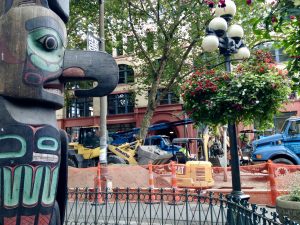
Real Disruption to the Neighborhood
Co-founder and producing director of Café Nordo Terry Podgorski has no regrets about finding a permanent home in Pioneer Square for Nordo’s “culinarium,” an immersive theater experience that offers a “crossroad between the culinary and performing arts.” However, the construction has been brutal since he and co-founder Erin Brindley located there in 2015.
“It’s been great overall being in Pioneer Square, but it’s a neighborhood going through a lot of change,” said Podgorski. “First they were redoing alleyways and then there was the gas and electrical work on Main [Street]. I think they’ve torn up the roads around us, in particular, the corner of 1st and Main, about five times and three years.”
All of that construction has made discussion of future projects a sensitive topic.
“It’s been tough,” said Christl Marcontell, owner of Kinesthesia Pilates. “This was the year I thought I would get a return on my investment after years of pouring my body and soul into my business.”
Marcontell, who has operated her business in Pioneer Square since 2004 is a believer in Pioneer Square’s potential as a “pedestrian-friendly small business corridor.” In 2015, Marcontell relocated to a storefront location on 1st Avenue with the hope of growing her business and establishing a retail presence. Slim first quarter profits, which she attributes to the impact of construction, has once again left her in a precarious situation.
However, Marcontell remains an ardent supporter of the CCC. “I knew it would be a long process,” said Marcontell. “I want the end of result of a pedestrian-friendly boulevard that will be more attractive to tourists and people traveling with families. The [streetcar] will be easy to jump on and jump off. More people will come down to Pioneer Square.”
Not everyone in Pioneer Square is as supportive. “My business partner [Erin Brindley] is supportive, but I don’t like the [streetcar]. I would have rather seen expanded light rail,” said Podgorski.
Yet even as a critic, Podgorski concedes that the CCC might be advantageous for his business. “I can see the potential benefit of connecting these neighborhoods,” he said. “I’m conflicted because I can see some benefits for our business. Parts of it are a great idea.”
But, the chaos and disruptions that have accompanied construction and the lack of communication between the Seattle Department of Transportation (SDOT), the construction company, and the impacted businesses has affected many small business owners’ perceptions of the project.
“It’s been bad. Right after the construction started, it had a huge damage to our business,” says Lusha Chen of Callus, a lifestyle brand collective from China, which opened a large storefront presence on 1st Avenue last year. “Also for [employees], commuting to work and loading stuff, it’s pretty hard.”
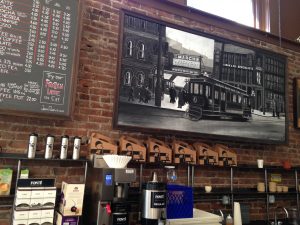
Like Callus, General Porpoise wanted to “be part of a historic neighborhood.” So far, there are no regrets about opening a new storefront on 1st Avenue, despite construction affecting the business’s profits. “On days the construction has been light around us, we see so many faces from the area and people are all around happy to be there,” said Reed McCoy, manager. “But when there is heavy construction around us, we see a large dip in foot traffic on the streets, and few people come in.”
Located on S. Jackson Street across from the terminus for the current First Hill Streetcar, Intrigue Chocolate owner Barthel has lived through the construction process twice now, and he has no doubt that the experience on 1st Avenue has been worse.
“The real utility work was done on 1st Avenue,” Barthel said. “You have the trees. You have the underground sidewalks. You have one hundred year-old infrastructure.”
“I think a lot of people don’t realize that the utility work was necessary regardless of the streetcar,” he added, alluding to the fact that for many people it has been difficult to disassociate the CCC from the invasive utility work, which was planned to be completed before the CCC construction began and not actually connected with the CCC project.
Lack of Awareness Around the CCC
When the CCC was first announced in 2014, it was hailed as a signature streetcar project that would “change the whole [national] conversation on streetcars.”
According to transit consultant Jarrett Walker, the problem with the first generation of North American streetcars was “with a few exceptions, they’ve been designed with the attitude that transit function isn’t really the point.”
Streetcars were marketed more for their potential to spur business and construction development than as serious transit tools. Thus many streetcars, including the South Lake Union and First Hill lines in Seattle, were designed to share the road with cars and buses, virtually wiping out their mobility benefits.
However, the CCC was designed to be different. For the 1.1 miles it will run through the downtown core, it will operate on its on own exclusive lane, greatly improving its speed and efficiency.
Somehow, apart from the pro-transit community, this message has simply not gotten out.
“The streetcar on Capitol Hill is really slow and a headache for me,” said Chen. “It creates more car traffic. In China, public transportation is underground. It’s different than here.”
It’s clear that Chen, who is worried about maintaining access to her business for vendors, has not been adequately informed about how the CCC would work, or that there are improvements planned for the existing First Hill streetcar.
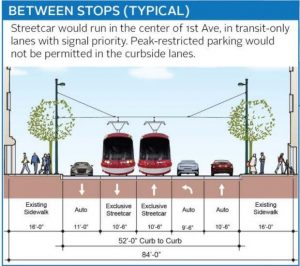
Podgorski was clear that a lack of awareness around the project has hurt its reputation with business owners. He blames the City.
“There’s no signage,” he said. “No signs saying, ‘We’re here and we are trying to improve this for this reason.’ They have show us what the CCC will look like and what the benefits will be.”
Jim Baird, who has owned his residential property overlooking 1st Avenue for over twenty years, also had similar difficulty understanding how the CCC would fit into the “current streetscape and flow of traffic.” As a substantial financial donor to the preservation of trees Pioneer Square, Baird was concerned about how the CCC’s presence might negatively impact the greenery of the street, but confessed that he had “no idea of the plan’s logistics.” After a careful review, he changed his mind. “I’m moderately open to the idea of the streetcar now,” Baird said, “as long as it doesn’t negatively impact the trees.”
The Alliance for Pioneer Square partnered with the City to inform business owners and held meetings early on to spread the word about the CCC. “There’s been more opportunity for knowledge than people have necessarily been able to take advantage of,” said Barthel. Many businesses in Pioneer Square are small and new, and informational outreach can fall off their radar, especially since many business owners need to provide both staffing and management at the same time.
Also, the pain of vanishing profits is real. “When you are hurting, when your business is in pain, that is the part that matters to you in that moment,” said Barthel.
Being situated across from the First Hill streetcar line has broadened Barthel’s perspective. “We did not see an explosion of traffic, but we definitely see a lot more people who live on Capitol Hill coming down to explore Pioneer Square,” said Barthel. “Every time a tourist or business traveler comes in here, and they want to see different parts of the city, I tell them the streetcar stops right there and it can take you places you want to go. I really look forward to directing them to the CCC.”
“I can’t imagine if you connect the streetcars that you wouldn’t just see a massive uptick in ridership,” he added.
Concerns also exist that the CCC will improve transit for tourists, but not for Seattle residents. However, those concerns may also be largely unfounded when it comes to the CCC, especially in regards to providing transit for vulnerable populations.
“I heard early on that there was speculation that it didn’t serve poor people, but there wasn’t any data or backup information about why people thought that,” said Howard. “In Pioneer Square, we have a really high number of low-income residents. To have a system that’s really easy to understand and connects us directly to the hospitals on First Hill, that’s really valuable. Streetcars are also really ADA accessible because it’s really easy to go from the platform onto an even, level car. It removes a lot of the steps of getting on to a bus.”
Reconsider the Process, Not the CCC Project
At the Alliance for Pioneer Square, Lisa Howard is a believer. She is a believer in the future of Pioneer Square, a neighborhood that was hit harder than almost any other in Seattle during the 2008 recession, and one that even now can live up to its historic nickname of “Skid Row.” Howard is also a believer in the CCC, not just as a new mobility tool for Pioneer Square and the Downtown core, but as an opportunity to show that transit can be done well.
At her office in the upper story of a historic building, Howard was effusive about how the recent pause in the CCC project can be used to make the CCC succeed:
We’re absolutely supportive of accountability and the need to address some of the system’s issues that are going on now on a city level. But we also think that this project can be something where our city government takes and implements those changes in accountability and cost-savings and demonstrates that they can do it well… We need to expand transit. The project has already been vetted. They are are uncovering issues, which they will be able to address, and they can implement those changes immediately.
At Intrigue Chocolate’s 600 square foot tasting room on S. Jackson Street, Barthel is sympathetic to small business owners’ worries that their businesses will not survive the additional years of construction. But he is also a believer that the entire construction and impact mitigation process can be rethought to benefit businesses.
Impact mitigation and financial payouts to businesses are difficult topics in Seattle. While the City’s approach has generally been not to give financial payouts, there have been some exceptions, including payments given to impacted small businesses on 23rd Avenue. However, those payments were awarded from federal grant funding and it is unlikely that small businesses in Pioneer Square will be eligible for similar compensation.
In reference to this situation, Barthel said, “There needs to be planning. If the city is unwilling to do business mitigation, they need to do activity mitigation.”
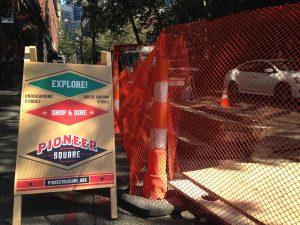
The City’s current impact mitigation plans for Pioneer Square are standard. After years of living with construction surrounding his business, Barthel has spent a lot of time thinking about how to keep businesses alive during construction and arrived at the conclusion that what is needed is a creative rethinking of construction zones:
Why not turn the liability on its head? There are so many competitions and festivals when things are made by designers and are donated or made for free. What if we try to make it joyful again? What if rather than just ‘open for business signs’, it becomes an art show, a competition? How can we make the scaffolding not gloomy but turn it into a green arbor with fast growing plants? People aren’t going to want to be there for the noise, but at night it’s quiet. Why not install an arcade of lights? We can make it so people feel safe and want to be here.
Mayor Durkan will need to come to a decision about the CCC soon–staff have indicated October is when she will finally decide (and apparently release the consultant report). While there are many factors to consider, if done correctly, the project can be a model in many ways.
At the moment, though, the small businesses of Pioneer Square need support from the greater Seattle community. For people who want to see the historic neighborhood thrive, it’s important to brave the construction headaches and come out.
“Have breakfast, lunch, or dinner at restaurants. Support our retailers during the day,” said Howard. “There’s still a huge concentration of arts and culture here to enjoy.”
Mayor Durkan Refuses to Meet with Coalition Backing Center City Streetcar
Natalie Bicknell Argerious (she/her) is a reporter and podcast host at The Urbanist. She previously served as managing editor. A passionate urban explorer since childhood, she loves learning how to make cities more inclusive, vibrant, and environmentally resilient. You can often find her wandering around Seattle's Central District and Capitol Hill with her dogs and cat. Email her at natalie [at] theurbanist [dot] org.

